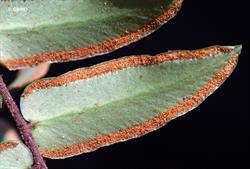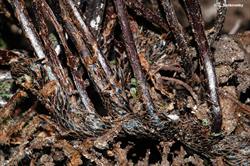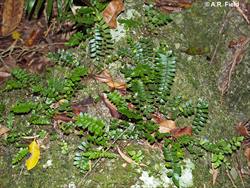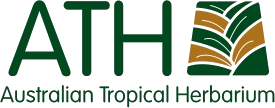Pteridaceae
Australian Tropical Ferns and Lycophytes - Online edition
Pellaea nana








Pellaea nana (Hook.) Bostock
Link to Australian Plant Name Index for publication details and synonyms: https://id.biodiversity.org.au/name/apni/137195
Dwarf Sickle Fern
Rhizome short- to medium-creeping; scales narrowly ovate, c. 1.5 mm long, basally attached, with a midrib of black occluded cells; margins entire, of paler brown open cells; apex attenuate and acute. Fronds (10–) 20–50 cm long. Stipes 5–20 cm long (20–50% length of frond), c. 2–5 mm apart, dark brown, ±cylindrical; stipe and rachis clothed with scales and uniseriate hairs; scales narrowly triangular, 1–2.5 mm long, spreading, persistent, brown. Lamina 1-pinnate, with 25–65 crowded sessile or shortly stalked pinnae (stalk less than 1 mm long). Pinnae oblong to linear-oblong, c. 5–25 mm long, 2.5–7 mm wide, dark green above, paler green beneath, stiffly herbaceous, ±glabrous; base truncate to cordate; margins entire, sometimes minutely crenate or toothed towards the apex; apex obtuse or acute; veins free and forked, obscure. Sporangia in a continuous marginal band c. 1 mm wide, absent from base and sometimes from apex; indusium marginal, membranous, obscured by sporangia at maturity. Spores trilete, ±globose, coarsely echinate.
Endemic to eastern
Plants terrestrial or lithophytic in montane tropical rainforest, subtropical rainforest and temperate rainforest. In
An attractive horticultural fern. Populations from tropical QLD tend to have crowded large rectangular pinnae. Some population in SE QLD have red new growth.
Easily cultivated in a small container or among rocks in the garden.
Pellaea calidirupium, Pellaea falcata and Pellaea paradoxa.
1a. rachis scales and hairs mid- to dark-brown, spreading = 2
1b. rachis scales and whitish to pale-brown appressed = 3
2a. rachis scales mostly 3–4 mm long, pinnae 22–56 mm long = Pellaea falcata
2b. rachis scales mostly 1–2.5 mm long, pinnae 5–25 mm long = Pellaea nana
3a. pinnae 20–60 mm long; all lateral pinnae the same length = Pellaea paradoxa
3b. pinnae 14–30 mm long; lateral pinnae reducing in length and width towards the frond apex = Pellaea calidirupium
Field AR, Quinn CJ, Zich FA (2022) Australian Tropical Ferns and Lycophytes. apps.lucidcentral.org/fern/text/intro/index.htm (accessed online INSERT DATE).
Field AR, Quinn CJ, Zich FA (2022) ‘Platycerium superbum’, in Australian Tropical Ferns and Lycophytes. apps.lucidcentral.org/fern/text/entities/platycerium_superbum.htm (accessed online INSERT DATE).







